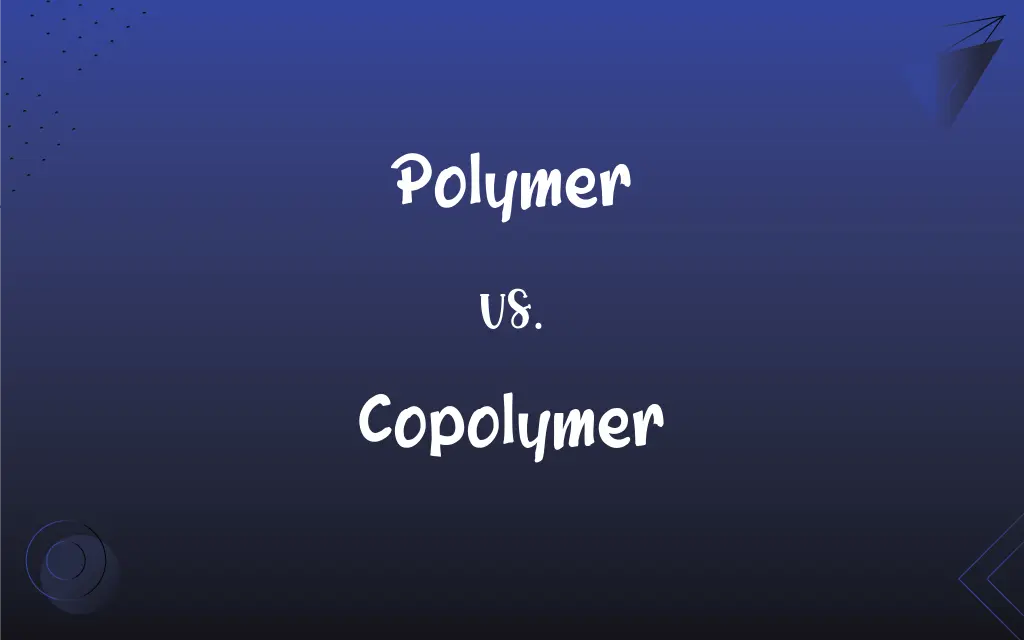Polymer vs. Copolymer: What's the Difference?
Edited by Aimie Carlson || By Janet White || Published on January 7, 2024
A polymer is a large molecule made of repeating units, while a copolymer is a polymer formed from two or more different types of monomers.

Key Differences
A polymer is a substance composed of large molecules that are chains of many repeating units, known as monomers. Copolymers, a subset of polymers, are formed by polymerizing two or more different types of monomers, resulting in a material with combined properties.
The properties of a polymer depend on the nature of the monomers and the structure of the molecular chain. In copolymers, the different monomers can influence physical and chemical properties, offering more versatility than single-monomer polymers.
Polymers can be natural, like DNA or cellulose, or synthetic, like polystyrene or polyethylene. Copolymers, such as styrene-butadiene rubber, combine different monomers to create materials with specific characteristics for targeted applications.
In polymers, the uniformity of a single type of monomer can limit functionality. Copolymers overcome this by integrating various monomers, enhancing properties like temperature resistance, strength, or flexibility.
The classification of polymers includes terms like homopolymer, where only one type of monomer is present. Copolymers are further classified based on how their monomers are arranged, such as block, random, or alternating copolymers.
ADVERTISEMENT
Comparison Chart
Monomer Composition
Single type of monomer
Two or more different types of monomers
Structural Variability
Limited, uniform structure
More varied, combining different monomers
Material Properties
Defined by single monomer characteristics
Combined properties of different monomers
Classification
Homopolymer, if one monomer type
Block, random, alternating, etc., based on arrangement
Application Flexibility
Specific to monomer type
Greater versatility for specific applications
ADVERTISEMENT
Polymer and Copolymer Definitions
Polymer
Formed by polymerization of monomers.
The polymerization of styrene results in polystyrene.
Copolymer
Offers combined properties of its monomers.
Acrylonitrile butadiene styrene (ABS) is a strong, resilient copolymer.
Polymer
A large molecule made from repeating subunits.
Polyethylene, a common polymer, is used in plastic bags.
Copolymer
A polymer made from two or more monomer types.
Styrene-butadiene rubber, a copolymer, is used in car tires.
Polymer
Can be natural or synthetic.
Natural polymers include cellulose in plant cell walls.
Copolymer
More versatile than single-monomer polymers.
Ethylene-vinyl acetate copolymer is flexible and clear, ideal for packaging.
Polymer
Has uniform repeating units.
PVC, a polymer, is used extensively in construction.
Copolymer
Can have a random, block, or alternating structure.
SBS (styrene-butadiene-styrene) is a block copolymer used in shoe soles.
Polymer
Determines material properties like strength and flexibility.
The polymer structure of nylon makes it strong and flexible.
Copolymer
Used for creating materials with specific characteristics.
Nitrile rubber, a copolymer, is resistant to oil and heat.
Polymer
Any of numerous natural and synthetic compounds of usually high molecular weight consisting of up to millions of repeated linked units, each a relatively light and simple molecule.
Copolymer
A polymer of two or more different monomers.
Polymer
(organic chemistry) A long or larger molecule consisting of a chain or network of many repeating units, formed by chemically bonding together many identical or similar small molecules called monomers. A polymer is formed by polymerization, the joining of many monomer molecules.
Copolymer
(chemistry) A polymer derived from more than one species of monomer.
Polymer
A material consisting of such polymer molecules.
Copolymer
A polymer consisting of two or more different monomers
Polymer
Any one of two or more substances related to each other by polymerism; specifically, a substance produced from another substance by chemical polymerization.
Polymer
A naturally occurring or synthetic compound consisting of large molecules made up of a linked series of repeated simple monomers
FAQs
What defines a copolymer?
A polymer made from two or more different types of monomers.
Can polymers be naturally occurring?
Yes, like DNA and proteins.
What's an example of a copolymer?
Styrene-butadiene rubber.
What properties can copolymers have?
They combine properties of their constituent monomers.
Can copolymers be recycled?
It depends on their composition and structure.
Can copolymers enhance material strength?
Yes, depending on their monomer composition.
What is a polymer?
A large molecule made from repeating monomer units.
Do polymers only have industrial uses?
No, they're also found in biological systems.
Are all plastics polymers?
Yes, plastics are synthetic polymers.
Are polymers biodegradable?
Some are, but many synthetic polymers aren't.
What's the difference in monomer variety between polymers and copolymers?
Polymers have one monomer type; copolymers have multiple.
What's a random copolymer?
A copolymer with monomers arranged randomly.
How are polymers formed?
Through a process called polymerization.
What's a block copolymer?
A copolymer where monomers are grouped in blocks.
Are copolymers more versatile than regular polymers?
Yes, due to the combination of different monomers.
Is rubber a polymer or copolymer?
Natural rubber is a polymer; synthetic rubber often is a copolymer.
Is Teflon a polymer or copolymer?
Teflon is a polymer, specifically polytetrafluoroethylene (PTFE).
Why use copolymers in textiles?
For improved durability, flexibility, and other properties.
How do polymers differ in structure?
They vary in chain length, branching, and cross-linking.
Can copolymers be used in medical applications?
Yes, for specialized uses like drug delivery systems.
About Author
Written by
Janet WhiteJanet White has been an esteemed writer and blogger for Difference Wiki. Holding a Master's degree in Science and Medical Journalism from the prestigious Boston University, she has consistently demonstrated her expertise and passion for her field. When she's not immersed in her work, Janet relishes her time exercising, delving into a good book, and cherishing moments with friends and family.
Edited by
Aimie CarlsonAimie Carlson, holding a master's degree in English literature, is a fervent English language enthusiast. She lends her writing talents to Difference Wiki, a prominent website that specializes in comparisons, offering readers insightful analyses that both captivate and inform.






































































